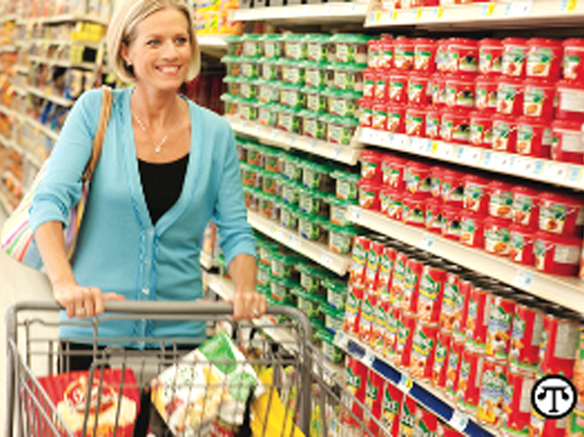(NAPS)—If you are like most Americans, you not only want to save money at the grocery store, but you want to save time, too. In fact, in a recent survey conducted by SupermarketGuru.com, 25 percent of respondents said they have resorted to grocery shopping online just to save time. How can you be sure to get the best value in the shortest time possible? Here are a few hints from Phil Lempert, the Supermarket Guru, that can help:
(NAPS)—If you are like most Americans, you not only want to save money at the grocery store, but you want to save time, too. In fact, in a recent survey conducted by SupermarketGuru.com, 25 percent of respondents said they have resorted to grocery shopping online just to save time. How can you be sure to get the best value in the shortest time possible? Here are a few hints from Phil Lempert, the Supermarket Guru, that can help:
• First, plan the timing of your shopping trip carefully. The supermarket’s busiest time is between 4 p.m. and 5 p.m., so avoid the supermarket “rush hour.”
• Use all your shopping resources. Check the store’s circulars and use the latest technology to help enhance your trip. For example, ReadySetEat.com not only lets you plan your meals and ingredients ahead of time, it instantly shares what items are on sale at a retailer near you.
• Discounts are often worth the time spent seeking them. According to a Red Plum survey of shoppers, 80 percent of consumers surveyed spent up to three hours each week looking for coupons, deals and savings from all sources and 81 percent said they saved up to $50 each week, or $2,600 a year.
• Frozen single-serve meals can be cost effective. Frozen meals such as Healthy Choice can be a great way for those on a budget to eat more healthfully and waste less food due to portion control.
• Private brands can be valuable. With their quality generally comparable to leading brands, private brands are some of the best and most underused finds in the supermarket. Savings vary, but the best deals in terms of price and quality include breakfast cereals, jams, cookies, pasta, sauces, dairy products, paper goods, and snacks like H.K. Anderson Pretzels and Kangaroo Baked Snacks.
• Consider frozen. When produce is not in season, you can head to the frozen and canned aisles. Frozen fruits and veggies are preserved at their peak of nutritional value, and in season. For example, Hunt’s tomatoes go from farm to can within 24 hours to lock in the fresh taste.
• Don’t assume the bigger package is the better deal. Consider the unit price on the shelf tag and buy what goes on sale. Pricing surveys have shown that some name-brand merchandise costs less at major grocery chains than at big warehouse stores.
• Finally, avoid waste. The Natural Resources Defense Council estimates that more than 40 percent of the food that Americans buy goes to waste. To avoid waste, follow these simple tips:
• To help reduce your personal waste, plan meals ahead of time, check expiration dates at the store and opt for portion-controlled frozen foods. Single-serve and family-size meals, such as Marie Callender’s or Bertolli frozen meals, are great examples of portion-controlled meals for yourself or your whole family.
• Also, remember to store leftovers properly. Refrigerate below 40° F within two hours or one hour during hot weather (90° F and above). Place unused raw vegetables in a sealable plastic bag and squeeze out excess air. For unused canned ingredients, remove from the original can, put them in a sealable container and cover tightly to maintain optimal flavor. Fresh vegetables should be blanched quickly in boiling water, drained and then placed in a bag. Poultry and meats can be frozen in their original wrappers, but then placed in a freezer bag.
Keep these tips in mind for your next grocery shopping trip, and you may find that you can come home with more money in your pocket and more time to spend with your family.





















